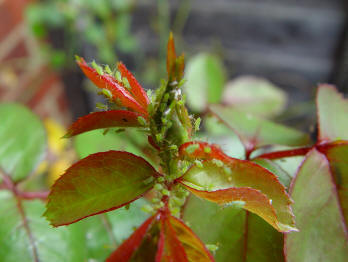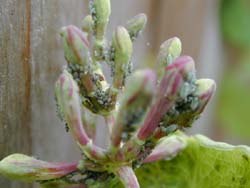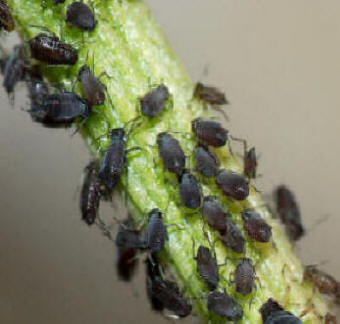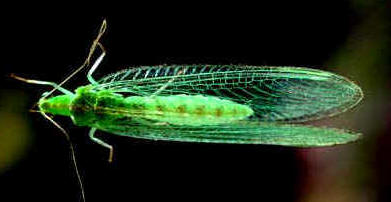Greenfly and Blackfly on Roses. Two of the main aphids that attack roses.
All roses are a target for the two main aphids - greenfly and Blackfly.
These aphids can soon take the strength out of your rose bushes if not checked in the initial stages.
The greenfly is by far the most common pest of roses, and as can be seen in the photo, they normally start feeding on the tender young shoots and buds.
If left untended, then the overall vigour of the rose bus will be affected, and often the flower buds will be so weakened as to not open.
Together with this, a sticky substance is exuded, which can soon lead to sooty mould - a black fungus. Greenfly and other common aphids on roses can be easily treated with a general insecticide, or a rose-specific chemical combined spray such as RoseClear. This will also deal with other pests and diseases such as blackspot on roses.

It will take more than one application to kill off the greenfly - aphids - on rose bushes. Be careful to read the instructions - especially for the timing of repeat applications.
There are organic solutions available, most of which are based upon horticultural soap. Soapy water from the kitchen will also wash off the greenfly - but not kill them, so they will soon reappear.
As can be seen in the image above, greenfly aphids attack the young buds of roses early in the year. Keep a close watch out for these aphids and treat them before they take hold.
Sprays for Rose Aphids
Rose Aphids - greenfly and black fly, can be treated with a variety of different chemicals. Permethrin based sprays have a systemic action - They are absorbed into the plant and all parts of the foliage, so kill off any bugs that you may have missed with your spraying action!
Other types of spray - such as Malathion are very effective and quick as sprays, killing the greenfly on contact. Liquid derris is similar in action and perhaps a little bit more environmentally friendly. If the infestation has been severe, it will be a good idea to help the rose to get over its setback with a good rose feed.
Soap and detergent sprays are often suggested as alternatives. Remember that these simply wash off the greenfly, which will then simply dust itself down and have another go! Horticultural soap acids are more effective.
Prevention is always better than cure, so preventative sprays for rose greenfly - early in the year - are a good idea.
You might like to brush up on your care regime for roses as well.
Best Selling Sprays for Roses
Aphids - (Blackfly, Greenfly, Woolly Aphids)
There seems to be an aphid for every occasion! Also known as 'blackfly', 'greenfly' or 'woolly aphids', they display a wide variation in colour and appearance.
Aphids overwinter as eggs on trees and shrubs. In Spring, as the weather warms up, the eggs hatch into aphids which then produce their own live young, (missing out the egg stage). Thus vast colonies can build up very quickly.
After several generations of wingless aphids, winged aphids are produced which can migrate to new host plants. Aphids feed by sucking out the plant's sap, causing deformed or stunted plant growth, damaged fruits and flowers, and curled leaves, sometimes with galls and blisters. Aphids can transmit viruses between plants, attract ants, and promote the growth of sooty mould.

A crop of greenfly on a Honeysuckle!
There are many different species of aphids that are problems in the garden. Some are specific to certain plants, others are happy to hunt around for a wide range of plants that have the necessary lush or tender foliage!
Basically, greenfly and blackfly are the most common groups of aphids, but are sometimes other colours - pink or orange even. No matter the colour, they are all pests. The other aphids - such as mealybugs - with their white waxed finish - are difficult to control. Same goes for woolly aphids.
Greenfly and blackfly both attract ants - who are rather partial to the honeydew secretion left by the feeding aphids. It is not correct to think that the ants will control the aphids - far from it.
Insecticide Sprays
Like it or not, the best of the insecticide chemical sprays are those of a synthetic - non organic - nature/manufacture. These can either be of a contact nature, where they will need to be sprayed on the aphids direct. Not normally a problem. The other type of chemical spray, is the systemic spray which gets taken into the plant, and is then made available via the sap for these sap sucking insects. the systemic types are best applied to smaller plants where the chemical can easily be translocated through the plant system. This is not generally the case with large plants or shrubs. More effective control is by use of 'contact sprays.
There are several organic sprays developed from natural toxins, including pyrethrum. These contact sprays will need to be actively applied all over the plant, and in particular under the foliage. They are not long lasting in effect, so may need more regular applications than their synthetic chemical counterparts.
Insecticidal horticultural soap can be used with some plants, and is claimed to give some success. So is ordinary household soapy water. The latter simply washes the aphids off - soon to return with seemingly no ill effects, but perhaps a little cleaner!
Pesticides/insecticides on fruit and other edible crops.
There are a number of pesticides which are suitable for edible crops, and these will be clearly marked on the label. You MUST read the label to ensure that you adhere to the instructions. In particular the recommended times between application and harvesting. Fruit bushes, vegetables of all types, ornamental plants, herbs and even chillies can be attacked by aphids.
Plants Infested By Aphids.
More or less any plant with good young foliage can fall prey to
either blackfly or greenfly. Notably roses attract greenfly and
Nasturtiums attract blackfly. Broad beans are notorious for providing a
feast for blackfly.
Some potted plants can be infected by root feeding aphids. These are best dealt with by drenching the root ball - pot and all in one of the above treatments.
Natural Predators - The common Lacewing : Ladybird - Hover bees and wasps.
Ladybirds, Lacewing larvae and Braconid parasites do attack aphids,
but rarely doing sufficient damage to aphid numbers to control
infestation.
There are many proprietary sprays and 'dusts' on the market; Choose carefully according to the type of plant, (e.g. edible, ornamental), to be sprayed, bearing in mind the stage of development of the plant as well as the aphid! Particular care is required when treating the Water-lily aphid if there are fish present in the pool or pond.
Ladybirds are often killed off by use of insecticide sprays. It is a shame and counter productive, for the ladybird's first culinary choice, is a dish (or plant full) of aphids. the larvae of the ladybird in particular can devour several times its bodyweight of the little pest s in a day. Morale being, that if you see ladybirds on a plant, DO NOT SPRAY! Let nature take its course.
Companion Planting
Marigolds emit a scent which is repugnant to greenfly and blackfly aphids. Don't be shy of planting a few of the larger growing African marigolds amongst your roses to help keep the pests away. The marigolds make a good colourful display as well. A bit of inter-planting with a row or two of French marigolds in the vegetable plot works wonders - especially with the lettuce. An added bonus is that the marigolds will be first target for slugs en route to your lettuce!
How to prevent Aphid blackfly and greenfly in the first place, is not something we are able to comment upon - other than experimenting with companion planting.
Black Fly - How to Get rid of Blackfly Aphids on Roses
The one good thing about Black Fly - or Blackfly - is that they are easy to see. Sometimes the other closely related aphid - the Greenfly, is not seen until it has taken a stranglehold on its plant meal.
As with all other Aphids, Black Fly is a sap sucker. It literally sucks the host plant to death. A little bit of exaggeration, in that it departs the plant that is giving it a feed, before it dies. A dead plant is of no use to this sap sucker!
As Black Fly are easy to see, we have the advantage of being able to deal with it - getting rid of it - before it can do too much damage. Even when we see the seemingly devastating effect of over-wintered broad beans, all is not lost. In this case, it simply puts the plant back a bit. kill the black fly, and the plant soon recovers.
There are three basic ways of dealing with a Black Fly infestation. Spray with an insecticide or puffer; using a biological control; or preventing them in the first place!

Blackly - along with the other Aphids - have a quite complicated life cycle, thus making them more difficult to control. For instance, the Black Fly female, is quite capable of producing live young - and eggs - without the help of the male! Live young are immediately able to feed upon the host plant. They do not have to wean on the mother Black fly, so getting in early with control measures is quite important.
As their name suggests, Black Fly can fly! This is part of their life cycle apparatus, in that the female flies off in the Autumn to lay eggs on a host plant which over-winter. The young are born with the ability to fly immediately in early spring; their first point of call is normally the over-wintered broad beans - which make a succulent meal before most other suitable plants start to grow.
More young are born - with wings - enabling a migration to the likes of Viburnum, Honeysuckle and then the later Dahlias. From there, off once again to perform the Winter Egg Laying off site!
Fortunately, the image shows the Blackfly at many times normal size. They are only a few millimetres long! Image by Joaquim Alves Gaspar,
Getting Rid of Black Fly.
The quickest way to get rid of Blackfly is to apply a spray as soon as you see the infestation. This will most certainly be on Broad Beans firstly, followed by French and Runner Beans, then ornamentals such as Dahlias, Poppies and nasturtium later. Later still, they will surface on the Autumnal foliage of Mock Orange (Philadelphus). Viburnum opulus types and Euonymus japonicus europus (The evergreen one).
- Natural Predators - exist for most garden pests, but our methods of gardening usually keeps these predators away or - worse still - kills the friendly predators off. The Ladybird in particular is an avid feeder on most Aphids - as are the larvae, which most would wrongly recognise as a pest! The rather beautiful Lacewing is another gobbler of Aphids, and much can, and should be done, to persuade Lacewings and Ladybirds to set up home in our garden.
- Natural Sprays for Killing Blackfly will include those based upon Pyrethrum or Horticultural Soap. These are not the most effective control for getting rid of Blackfly - but they are considered as being 'organic'!
- Contact Spray of BlackFly include Bayer Sprayday (Deltamethrin). Used directly at the clusters of Blackfly - or other Aphids.
- Systemic Control of Blackfly - is absorbed into the plant tissue and sap, and is therefore very effective at killing off Black Fly and other Aphids over a period of time. Scotts Bug Clear Ultra is fine but MUST NOT BE USED FOR EDIBLE CROPS!
- Edible Crops and Blackfly. Bayer Provado ultimate Bug Killer is suitable for most ornamental, and a wide range of edible crops. READ the instructions on the pack to see which edible crops can be treated. The old favourite of Permethrin is not now allowed for use.
- Overwintered Eggs of Blackfly can be attacked with a general purpose oil based winter wash. Winter Tar wash is no longer applicable!
- Biological Control - is comparatively expensive, but effective - if you can create the right conditions. The main problem being that there will be a time lag between being able to source the biological control of Blackfly. Together with this, there will need to be enough Blackfly for the biological predators to act upon.
Quick Questions
How long do black flies last?
Blackflies start appearing in the middle of May and the season can last until early July. Each Black fly will only last 2 to 3 weeks in its fly form, you can follow the Life Cycle of Blackfly.
What keeps black flies away?
These work to a certain extent, if the femail is hungry enough, she will still bite.
Make up your own repellant mixture, simply, mix 8 parts water, with 1 part vinegar and add a few drops of spearmint, mint or peppermint. Shake well and put into a spray bottle, spray yourselves and pets, if there is a place where you sit, spray the area. It is a cheap method and keeps away the majority of blackflies.
Wear Light Clothes. Wear light clothes, whites and beiges are ideal, avoid dark colours and try to wear long sleaves and pants if you keep getting bothered.
The final simple method is spearmint, mint or peppermint airfreshners, hang them around where you sit or place an airfreshner in line with a fan to disperse the scent around.
Do black flies die after they bite you?
It is the Female Blackfly which bites, it requires nutrients from your blood to provide food for its eggs. There fore it will bite you just before it is going to lay its eggs. So they do not die after feeding on you, they need to feed on you to survive.
What attracts black flies in the house?
Blackflies enjoy a different environment to our houses, they do not like to stray too far from water. What does attract blackflies to houses are dark colours. White houses attract fewer flies than bright and dark coloured houses.
Popular Gardening Sections

Problems
Identify Weeds in The Garden - How to deal with weeds. Diseases and Pest which harm your garden and plants, learn how to prevent, deter and erradicate your garden problems.
Garden Problems
Pruning
Pruning Guide. Shrubs flower better with correct pruning. Many illustrations and examples of what to do - and when. Includes evergreens, roses, flowering shrubs, spring flowering shrubs and pruning for stem effect. This is our most viewed and comprehensive section,
Pruning
Gardening Businesses
Gardening Businesses listed in the UK counties and USA states. County and State Listings of businesses involved in Garden supplies and services. If you wish to be added to the Directory, please send us your information. Having problems, use the search box
Businesses
Gardening
In this section you will learn about Gardening Basics, Containers, Landscaping, Propagation and Soil.
Gardening
Gardening Gifts
Gardening Gifts and Reviews, Read Before you Buy
- Gardening Gifts Ideas
- Gifts For Her
- Gifts For Men
- Power Tool Gifts
- Cheap Gifts
- Personalised Gifts
- Wildlife Gifts
- Family Gifts




